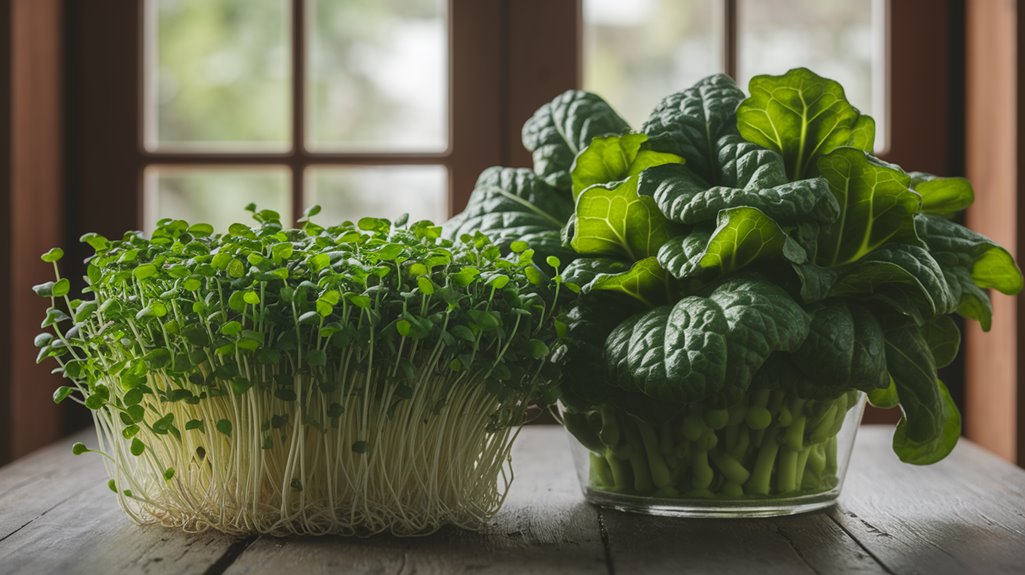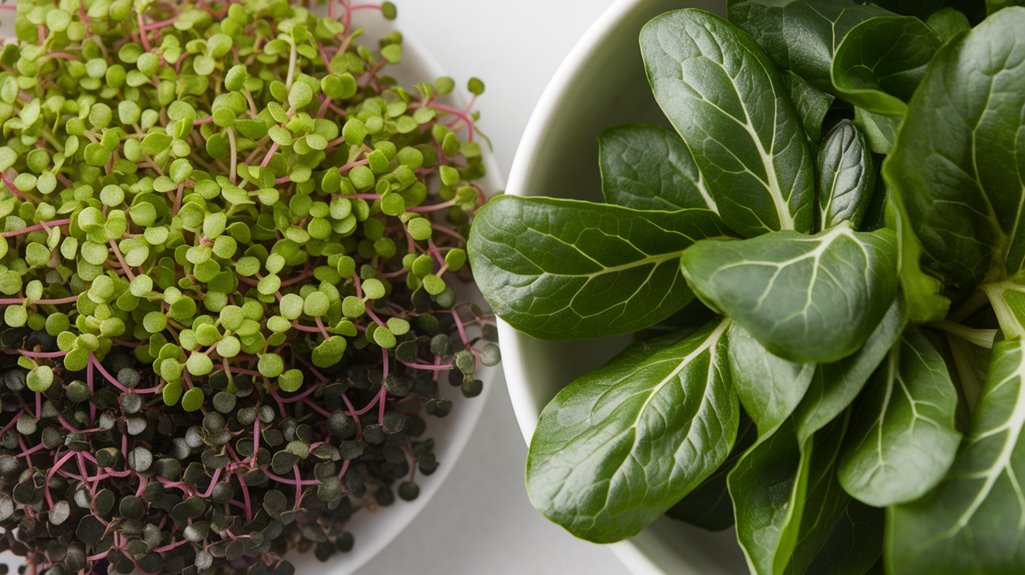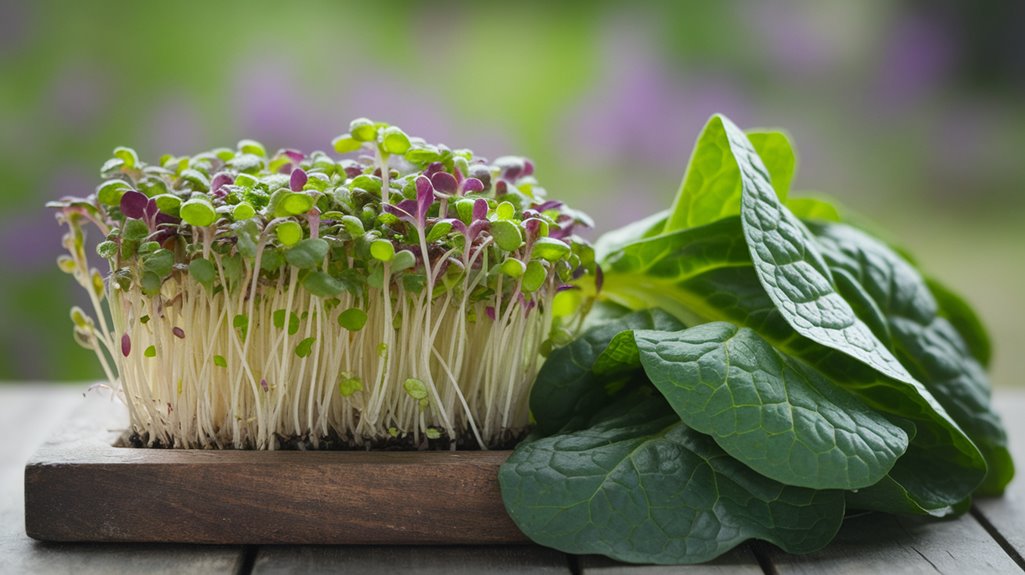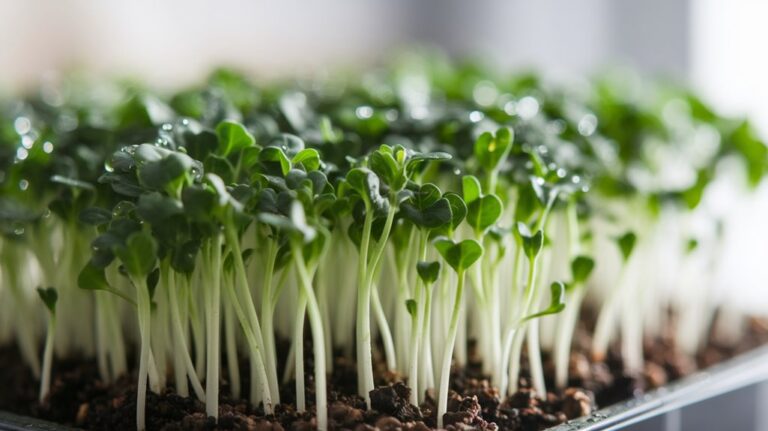Microgreens vs. Mature Greens: Which Packs More Nutrition?
When it comes to nutrition, microgreens often outshine mature greens, boasting up to 40 times more vitamins and minerals. They’re packed with essential nutrients like vitamin C, E, and beta-carotene, which can boost your immune system and energy levels. However, mature greens offer dietary fiber and a broader range of vitamins and minerals, supporting digestion and satiety. Balancing both types in your diet can optimize nutrition and flavor. There’s so much more to discover about each!
Key Takeaways
- Microgreens are highly nutrient-dense, containing up to 40 times more vitamins and minerals than mature greens per weight.
- They provide concentrated antioxidants and vitamins C, E, and beta-carotene, especially in varieties like kale and radish.
- Mature greens offer significant dietary fiber, aiding digestion and promoting satiety for weight management.
- While microgreens deliver quick nutrient boosts, mature greens provide sustained energy through complex carbohydrates.
- A balanced diet incorporating both can enhance overall nutrition and flavor variety in meals.
Understanding Microgreens: What Are They?

Microgreens are the tiny, young plants harvested just after the first leaves, or cotyledons, have developed. I’ve found that they come from various vegetables, herbs, and even some grains.
They’re typically harvested within 7 to 21 days after germination, which makes them a quick and rewarding crop for gardeners. Growing them requires minimal space and resources, making them perfect for urban settings or small kitchens.
What I love most is their vibrant colors and intense flavors, which can elevate any dish. They’re often grown in soil or hydroponically, and they can thrive indoors or outdoors.
Microgreens not only add aesthetic appeal to meals but also offer a fun way to engage with gardening, even for novices.
The Nutritional Profile of Microgreens
When I compare microgreens to mature greens, I’m often impressed by their nutrient density.
Research shows that microgreens can pack more vitamins, minerals, and antioxidants per serving than their fully grown counterparts.
Let’s explore how these tiny greens contribute to a healthier diet.
Nutrient Density Comparison
Nutrient density is a crucial factor when evaluating the health benefits of various greens, and microgreens often stand out in this regard.
When I compare them to their mature counterparts, the differences are striking. Research shows that microgreens can contain up to 40 times more vitamins and minerals than fully grown plants.
For instance, varieties like kale and radish microgreens are particularly rich in nutrients such as vitamin C, vitamin E, and beta-carotene. This concentrated nutritional profile means I can easily incorporate a small amount of microgreens into my diet for a significant health boost.
Antioxidant Levels Explained
While many people know about the vitamins and minerals in microgreens, their antioxidant levels deserve equal attention.
Research shows that microgreens often contain significantly higher antioxidant concentrations compared to their mature counterparts. For instance, studies reveal that varieties like red cabbage and kale deliver up to 40 times more vitamin C and other antioxidants.
These compounds play a crucial role in neutralizing free radicals, which can lead to chronic diseases. When I include microgreens in my diet, I’m not just adding flavor; I’m boosting my body’s defense mechanisms.
This increased antioxidant capacity is one reason why incorporating microgreens can be a smart choice for those looking to enhance their overall health and well-being.
Vitamins and Minerals Content
Although many people overlook them, microgreens pack a remarkable nutritional punch, offering an impressive array of vitamins and minerals.
Research shows that these tiny greens can contain up to 40 times more nutrients than their mature counterparts. For instance, varieties like broccoli microgreens are rich in vitamins C, E, and K, while others like radish microgreens boast high levels of potassium and magnesium.
These nutrients support immune function, bone health, and overall well-being. Additionally, the bioavailability of these vitamins in microgreens is often higher, meaning our bodies can absorb them more efficiently.
Incorporating microgreens into your diet not only enhances flavor but also provides a concentrated source of essential nutrients that can contribute significantly to your health.
Exploring Mature Greens: A Closer Look
When I think about mature greens, I’m struck by their impressive nutritional density, which can often surpass that of microgreens.
Their versatility in cooking also opens up a world of flavor profiles and textures, making them a staple in many dishes.
Let’s explore how these attributes set mature greens apart and their role in a balanced diet.
Nutritional Density Overview
Mature greens offer a rich source of essential nutrients that can significantly enhance our diets. When I dive into the nutritional profiles of leafy vegetables like spinach, kale, and Swiss chard, I’m often amazed by their vitamin and mineral content.
For instance, kale is packed with vitamins A, C, and K, while spinach provides a hefty dose of iron and folate. These nutrients support immune function, bone health, and energy levels.
Additionally, mature greens often contain fiber, which aids digestion and promotes satiety. I find it fascinating that the nutrient density of these greens can contribute to overall health, making them a crucial component of a balanced diet.
Simply put, incorporating mature greens can elevate our nutritional intake significantly.
Cooking Versatility Benefits
While exploring the world of greens, I often find that mature greens offer remarkable cooking versatility, making them a staple in many kitchens. Their robust textures and flavors allow for a variety of cooking methods, whether it’s sautéing, steaming, or even grilling.
Here’s a quick comparison of some common mature greens and their cooking uses:
| Green | Common Cooking Methods | Nutritional Highlight |
|---|---|---|
| Spinach | Sauté, Steam, Bake | High in iron |
| Kale | Sauté, Roast, Blend | Rich in vitamins A, K |
| Swiss Chard | Sauté, Steam, Stir-fry | Packed with magnesium |
These greens not only add nutritional benefits but also enhance the overall texture and substance of dishes, making them incredibly versatile ingredients to work with.
Flavor Profile Differences
Although many greens share a similar nutrient profile, their flavor profiles can vary significantly, influencing how they enhance a dish.
Mature greens like kale and collard greens often have robust, earthy flavors that can stand up to hearty dishes. Their bitterness can be balanced with fats or acidity, making them versatile in cooking.
On the other hand, greens like spinach and Swiss chard offer a milder taste, with subtle sweetness that pairs well in salads or lightly sautéed.
I find that the flavor intensity of mature greens can also depend on their preparation—cooking can deepen flavors, while raw greens provide a fresher, crisp bite.
Understanding these differences helps me choose the right greens for each culinary creation.
Nutritional Comparisons: Microgreens vs. Mature Greens
When comparing the nutritional profiles of microgreens and their mature counterparts, it becomes clear that both offer unique benefits.
Microgreens are often touted for their high concentrations of vitamins, minerals, and antioxidants. Studies show that they can contain up to 40 times more nutrients like Vitamin C, E, and K than mature greens.
On the flip side, mature greens provide a broader range of fiber and complex carbohydrates, making them beneficial for digestive health.
While microgreens shine in nutrient density, mature greens generally offer a well-rounded nutritional profile. Depending on your dietary needs, incorporating both into your meals can enhance overall nutrition.
I encourage you to experiment with both to see which fits your lifestyle and health goals best.
Health Benefits of Microgreens

Microgreens pack a powerful punch when it comes to health benefits, and I’ve found they can be a game changer in my diet.
These tiny greens are rich in essential vitamins, minerals, and antioxidants, often containing higher nutrient levels than their mature counterparts. For instance, they can provide up to 40 times more nutrients than fully grown plants.
I’ve noticed that incorporating microgreens into my meals boosts my energy levels and enhances my overall well-being. They also support heart health, improve digestion, and may even aid in reducing inflammation.
With their concentrated nutrient profile, adding microgreens to salads, smoothies, or sandwiches is an easy way to elevate my nutrition without much effort. It’s a simple yet effective strategy for healthier eating.
Advantages of Mature Greens
While microgreens offer impressive health benefits, mature greens also have their own distinct advantages. One major benefit is their higher fiber content, which aids digestion and helps maintain a healthy weight.
Mature greens, like kale and spinach, contain a broader range of vitamins and minerals, including iron, calcium, and vitamin K, which are essential for bone health and overall well-being. They also tend to be more versatile in meal preparation, allowing for various cooking methods—steaming, sautéing, or baking—enhancing their flavors and textures.
Plus, the more substantial leaves provide a satisfying crunch that many people enjoy. Ultimately, incorporating mature greens into my diet ensures I gain a wider spectrum of nutrients that support my long-term health.
Culinary Uses: Incorporating Both Into Your Diet

Incorporating both microgreens and mature greens into my diet not only enhances the nutritional value of my meals but also adds variety to my culinary repertoire.
I love tossing microgreens like arugula or radish into salads for a peppery kick or using them as a vibrant garnish on soups. Their delicate textures elevate dishes without overwhelming flavors.
On the other hand, mature greens, such as kale and spinach, serve as hearty bases for stir-fries, smoothies, and sautés. I often blend them into smoothies for a nutrient boost or sauté them with garlic for a simple side dish.
Making the Right Choice for Your Nutrition
How do I choose between microgreens and mature greens for my nutrition?
It really depends on what I’m looking for. Microgreens are nutrient-dense, often packing higher levels of vitamins and antioxidants in a smaller volume. They’re great for boosting my intake of certain nutrients quickly.
On the other hand, mature greens, like kale and spinach, offer fiber and sustained energy that microgreens can’t match. If I need a quick nutrient boost, I’ll lean towards microgreens, but for a filling salad or side dish, mature greens are my go-to.
Balancing both in my diet allows me to enjoy a variety of flavors while maximizing nutritional benefits. Ultimately, it’s about what fits my dietary needs and preferences best.
Frequently Asked Questions
Conclusion
In conclusion, both microgreens and mature greens offer unique nutritional benefits worth incorporating into your diet. Microgreens tend to pack a concentrated punch of vitamins and antioxidants, while mature greens provide essential fiber and larger amounts of certain nutrients. By mixing both into your meals, you can enjoy a diverse range of flavors and health benefits. Ultimately, it’s about balance, so I encourage you to experiment with both to find what works best for your nutritional needs.







